Main takeaway: For investors seeking steady passive income, a mix of traditional high-dividend ETFs and income-enhancing covered-call ETFs can balance yield with capital appreciation. Traditional dividend ETFs offer broad market exposure, while covered-call ETFs deliver higher current income at the cost of some upside participation.
1. Engaging with Income: A Swiss Watch Analogy
Investing for dividends is like owning a meticulously crafted Swiss watch. The gears (your underlying stocks) tick steadily, while the ticking sound (dividend payments) reminds you of consistent, reliable progress. Just as a watchmaker designs for precision and durability, dividend ETFs are engineered to provide stable income over time.
2. Traditional Dividend ETFs: The “Engine” of Income
Vanguard High Dividend Yield ETF (VYM)
- Yield: ~3.2%
- Expense Ratio: 0.06%
Tracks the FTSE High Dividend Yield Index, offering broad exposure to U.S. companies with above-average yields.
Schwab U.S. Dividend Equity ETF (SCHD)
- Yield: ~3.9%
- Expense Ratio: 0.06%
Focuses on high-quality U.S. stocks with a history of dividend growth and strong fundamentals.
SPDR S&P Dividend ETF (SDY)
- Yield: ~2.7%
- Expense Ratio: 0.35%
Invests in companies in the S&P Composite 1500 with at least 20 consecutive years of dividend increases.
iShares Core High Dividend ETF (HDV)
- Yield: ~3.7%
- Expense Ratio: 0.08%
Selects U.S. stocks screened for high dividend yields and financial health.
Invesco S&P 500 High Dividend Low Volatility ETF (SPHD)
- Yield: 3.33%
- Expense Ratio: 0.30%
Combines high dividend yield with low volatility by investing in the least volatile, high-yielding S&P 500 stocks.
SPDR S&P U.S. Dividend Aristocrats UCITS ETF (SPYD)
- Yield: 2.99%
- Expense Ratio: 0.35%
Holds U.S. companies with 20+ years of dividend increases, blending quality with income.
Vanguard Dividend Appreciation ETF (VIG)
- Yield: ~1.7%
- Expense Ratio: 0.06%
Targets companies with strong histories of increasing dividends, focusing more on growth.
iShares Select Dividend ETF (DVY)
- Yield: ~3.5%
- Expense Ratio: 0.39%
Screens for U.S. stocks with high dividend yields and stable payouts.
Global X SuperDividend ETF (SDIV)
- Yield: 10.91%
- Expense Ratio: 0.58%
A global basket of 100 equally-weighted highest dividend–paying companies.
WisdomTree U.S. Dividend Growth Fund (DGRW)
- Yield: ~1.6%
- Expense Ratio: 0.28%
Focuses on U.S. companies expected to grow dividends, combining yield with long-term growth.
3. Covered-Call ETFs: “Income-Boosters” with a Trade-Off
Covered-call ETFs sell call options on their holdings to generate option premiums, enhancing yield but capping upside participation. They are akin to a shepherd who rotates grazing fields: yielding consistent return (income) while sacrificing some of the pasture (stock gains).
- JPMorgan Equity Premium Income ETF (JEPI)
Yield: 8.4% – Expense Ratio: 0.35%
Actively managed U.S. equity portfolio with equity-linked notes overlay, aiming for defensive income. - Global X Nasdaq 100 Covered Call ETF (QYLD)
Yield: 12.1% – Expense Ratio: 0.60%
Tracks the Nasdaq-100 BuyWrite Index, selling calls to deliver monthly income. - Global X S&P 500 Covered Call ETF (XYLD)
Yield: 10.91% – Expense Ratio: 0.60%
Employs a buy-write on the S&P 500, offering reliable monthly distributions.
4. Yield Comparison Chart
Below is a bar chart illustrating how covered-call ETFs’ yields stack up against a traditional high-dividend ETF:

5. How to Choose Between Traditional and Covered-Call ETFs
- Income needs vs. growth potential:
- Traditional ETFs offer moderate yields and full participation in market rallies.
- Covered-call ETFs deliver higher yields but cap upside beyond strike prices.
- Volatility tolerance:
- Covered-call strategies cushion small downturns via premiums but lag sharply in strong bull markets.
- Expense considerations:
- Covered-call ETFs often have higher expense ratios (0.35–0.60%) versus 0.06–0.39% for traditional ETFs.
- Tax implications:
- Option premium income may be taxed differently than qualified dividends, depending on jurisdiction.
6. Key Takeaways
- Traditional dividend ETFs (e.g., VYM, SCHD) provide broad market exposure with stable, moderate yields.
- Covered-call ETFs (JEPI, QYLD, XYLD) can boost income to 8–12% but limit upside.
- Expense ratios and tax treatment are crucial when selecting the right vehicle.
- A balanced portfolio may combine both ETF types to optimize yield and growth.
7. Conclusion and Next Steps
Dividend investing is like mounting a Swiss alpine expedition: choosing reliable partners (ETFs) and balancing risk (upside cap) with steady progress (income). In the next post, we will explore tax-efficient structures and global diversification for dividend portfolios, guiding you further up the peak of passive income success.
